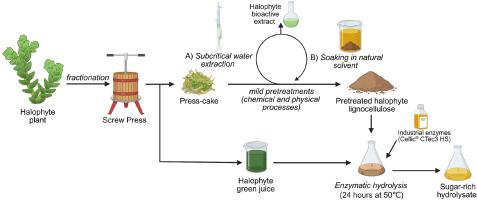低投入预处理盐生木质纤维素的高酶转化
IF 5.8
2区 生物学
Q1 AGRICULTURAL ENGINEERING
引用次数: 0
摘要
本研究探索了一种环境友好的替代盐生植物木质纤维素的预处理,利用一种新的浸泡-提取循环。对盐生植物木质素纤维素的成分分析表明,盐生植物木质素纤维素的多糖含量为41 ~ 55 g/100 g。浸渍-萃取工艺富含天然植物源性溶剂(NPDS),可作为天然催化剂,显著促进酶解糖化。双浸泡-萃取循环使水解率达到90%,水解产物的释放糖含量达到64 g /L,超过传统方法。近50%的木质素和60%的半纤维素被去除,有效地降低了木质素屏障,提高了酶的可及性。除了预处理优化之外,本研究还评估了用于酶糖化的合成缓冲液的天然替代品。盐生植物汁液及其变体显示出作为缓冲液替代品的潜力,果汁浆的水解率与合成醋酸缓冲液相当,浆液和醋酸缓冲液分别产生37 g/L和42 g/L的释放糖。总的来说,本研究通过整合双重功能的浸泡-提取循环,为盐生植物为基础的生物精炼提供了一种具有成本效益和循环的方法,既可以提取生物活性化合物,也可以预处理木质纤维素。这些发现突出了工业应用的巨大潜力,减少了对危险化学品和能源密集型方法的依赖。本文章由计算机程序翻译,如有差异,请以英文原文为准。

Low input pretreatment of halophyte lignocellulose for high enzymatic convertibility
The present study explores an environmentally friendly alternative for the pretreatment of halophyte lignocellulose by utilizing a novel soaking-extraction cycle. Compositional analysis of Salicornia ramosissima lignocellulose confirmed its high polysaccharide content, ranging from 41 to 55 g/100 g dry matter of halophyte lignocellulose. The soaking-extraction process, enriched with natural plant derived solvent (NPDS), functioned as a natural catalyst, significantly enhancing enzymatic saccharification. A double soaking-extraction cycle resulted in a 90 % hydrolysis yield and an significant 64 g of released sugars/L of hydrolysate, surpassing conventional methods. Nearly 50 % of lignin and 60 % of hemicellulose were removed, effectively reducing the lignin barrier and improving enzyme accessibility. In addition to pretreatment optimization, this study evaluated natural alternatives to synthetic buffers for enzymatic saccharification. Halophyte juice and its variants demonstrated promising potential as buffer alternatives, with juice slurry achieving a hydrolysis yield comparable to synthetic acetate buffer, yielding 37 g of released sugars/L with slurry and 42 g/L with acetate buffer, respectively. Overall, this study introduces a cost-effective and circular approach for halophyte-based biorefineries by integrating a dual-function soaking-extraction cycle that enables both bioactive compound extraction and lignocellulose pretreatment. The findings highlight significant potential for industrial applications, reducing reliance on hazardous chemicals and energy-intensive methods.
求助全文
通过发布文献求助,成功后即可免费获取论文全文。
去求助
来源期刊

Biomass & Bioenergy
工程技术-能源与燃料
CiteScore
11.50
自引率
3.30%
发文量
258
审稿时长
60 days
期刊介绍:
Biomass & Bioenergy is an international journal publishing original research papers and short communications, review articles and case studies on biological resources, chemical and biological processes, and biomass products for new renewable sources of energy and materials.
The scope of the journal extends to the environmental, management and economic aspects of biomass and bioenergy.
Key areas covered by the journal:
• Biomass: sources, energy crop production processes, genetic improvements, composition. Please note that research on these biomass subjects must be linked directly to bioenergy generation.
• Biological Residues: residues/rests from agricultural production, forestry and plantations (palm, sugar etc), processing industries, and municipal sources (MSW). Papers on the use of biomass residues through innovative processes/technological novelty and/or consideration of feedstock/system sustainability (or unsustainability) are welcomed. However waste treatment processes and pollution control or mitigation which are only tangentially related to bioenergy are not in the scope of the journal, as they are more suited to publications in the environmental arena. Papers that describe conventional waste streams (ie well described in existing literature) that do not empirically address ''new'' added value from the process are not suitable for submission to the journal.
• Bioenergy Processes: fermentations, thermochemical conversions, liquid and gaseous fuels, and petrochemical substitutes
• Bioenergy Utilization: direct combustion, gasification, electricity production, chemical processes, and by-product remediation
• Biomass and the Environment: carbon cycle, the net energy efficiency of bioenergy systems, assessment of sustainability, and biodiversity issues.
 求助内容:
求助内容: 应助结果提醒方式:
应助结果提醒方式:


